The Featured Creatures collection provides in-depth profiles of insects, nematodes, arachnids and other organisms relevant to Florida. These profiles are intended for the use of interested laypersons with some knowledge of biology as well as academic audiences.
Introduction
Two species of Jadera are known from Florida, Jadera antica Walker and Jadera haematoloma (Herrich-Schaeffer), but only the latter species is common. When Jadera haematoloma appears in large colonies in yards and gardens, people become curious and/or alarmed and contact agricultural officials for information. Mothers often become upset over their children's clothes being stained red from the squashed bodies of Jadera haematoloma, due to their children playing on infested lawns. The bugs aggregate to feed on seeds that have dropped to the ground from trees overhead, especially from goldenrain trees, Koelreuteria spp. (Sapindaceae). Wheeler (1982) documented Jadera haematoloma as a nuisance insect in Texas and having invaded homes from nearby Chinaberry trees in Oklahoma. Jadera bugs are often confused with the boxelder bug, Boisea trivittatus (Say), but they are different species in the same insect family. Boxelder bugs also cause concern when they appear in great numbers at the end of summer or early fall.
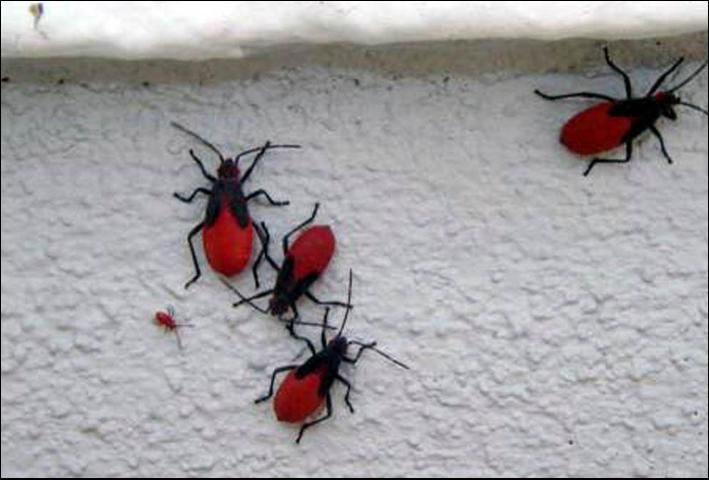
Credit: Robert E. Wilt, Jr.
Synonymy
Jadera haematoloma was described previously in the genus Leptocoris and has been recorded in Serinetha, Lygaeus, and Pyrrhotes. Jadera antica (Walker) is the name currently accepted for Jadera sanguinolenta (Fabricius) of various authors having reported it in southern Florida and islands south of Florida. The true sanguinolenta is a Neotropical species that occurs in Puerto Rico and the Virgin Islands, but not in the continental U.S.A.
Distribution
Jadera haematoloma has been reported from some of the southeastern states west to Texas and California, several central states, and from Mexico, the West Indies, southward to Central America and Colombia; also, Hawaii. In Florida, it ranges over the peninsula, but seems to be scarce in the north, and strangely absent from the Florida panhandle, as discerned from records in the Florida State Collection of Arthropods (FSCA). Jadera haematoloma has been taken during every month in Florida, with May being the peak month, primarily in central Florida, the region containing the majority of records. In southern Florida, there is a more even distribution throughout the year, with no distinct spring peak according to FSCA records. Jadera antica records are scarce; it has been collected only a few times in Monroe and Dade counties, and once in Osceola (15-III-56 by H.A. Denmark). Records (FSCA) for J. antica in Florida are in March, April, June, August, and November.
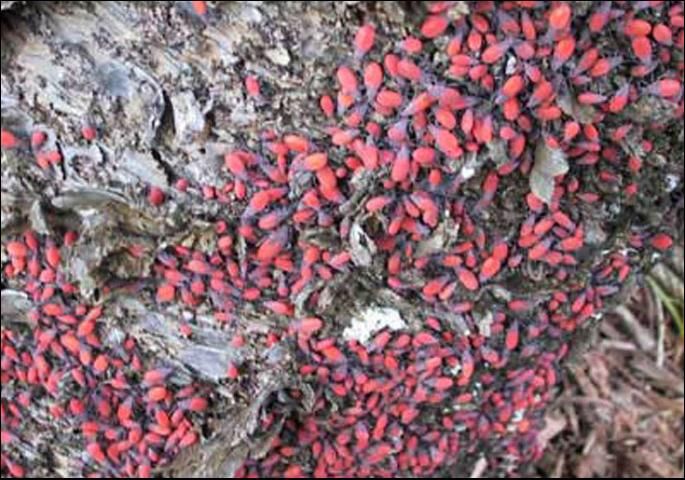
Credit: Ronald Sperry
Descriptions
Adults
Jadera haematoloma (with normal wings) has a length of 9.5 to 13.5 mm (~1/3 to ½ in) and width of 3 to 4 mm (~1/8 to 3/16 in). The length of the shortwinged form (brachyptera) usually is 7 to 8 mm (~1/4 to 1/3 in) long. Jadera haematoloma adults are mostly black or brownish-black, but their eyes, orbits and ocelli are reddish, as are their shoulders and the borders of their abdomens. Jadera antica has a length 7.5 to 11 mm (~3/8 to 7/16 in) and a width 2.5 to 4.0 mm (~1/16 to 1/8 in). Jadera antica is basically brownish-salmon in color, with some specimens more brownish, others more reddish; fuscous dots are abundant over the upper surface and on the sides of the thorax, eyes, sides of head, and shoulders. The abdomen is reddish with darker red spots. For more detailed technical descriptions or keys, consult Blatchley (1926), Gollner-Scheiding (1979), or Hoebeke and Wheeler (1982). For a broader understanding of Jadera and its relatives, consult Chopra (1967) and Schaefer and Chopra (1982).
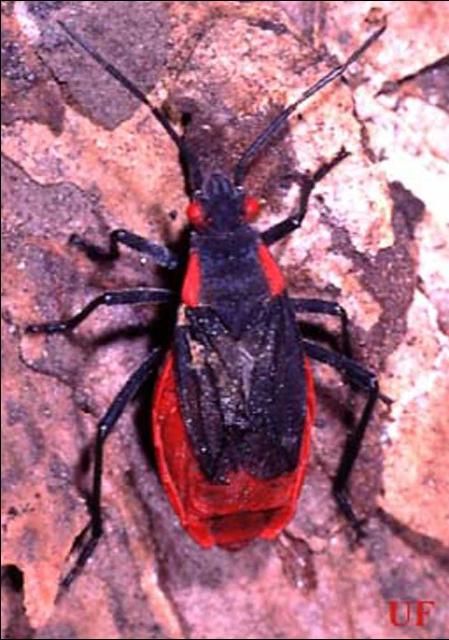
Credit: Paul M. Choate, UF/IFAS
Nymphs
The nymphs of both species are predominately red, except for the thorax, antennae, beak, and legs, which are brown. Small dark setae are nearly uniformly spaced over the whole body as revealed by a hand lens or microscope. The nymphs have the family characteristic of two abdominal scent glands lying so close together in the middle of the dorsal abdomen that segment 5 is constricted at midline.
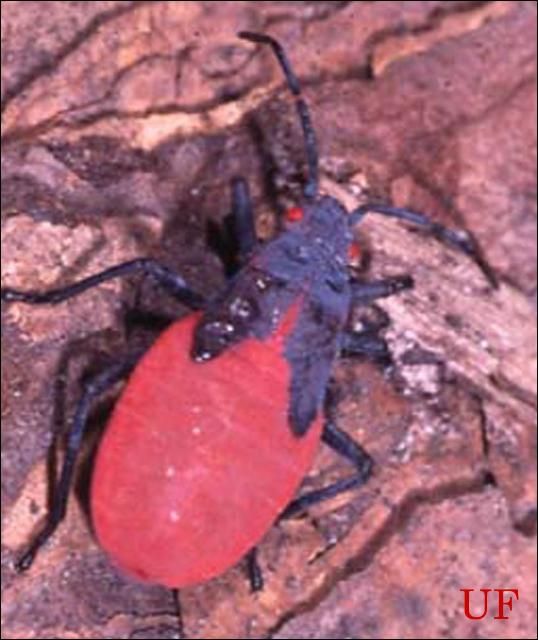
Credit: Paul M. Choate, UF/IFAS
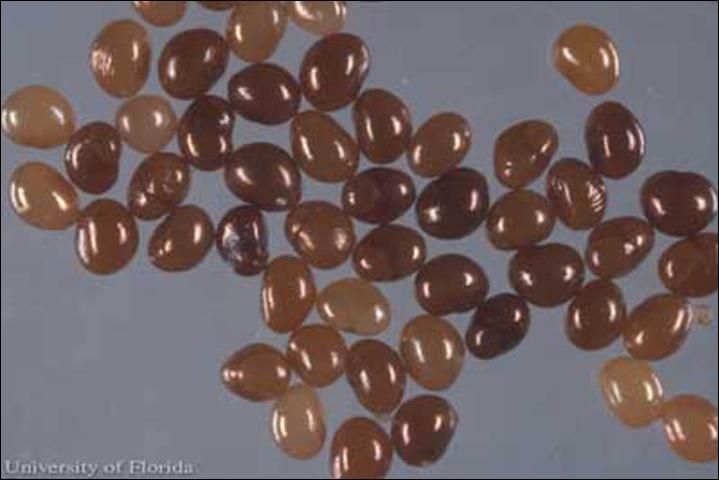
Credit: L. J. Buss, UF/IFAS
Hosts
Schaefer and Chopra (1982) reported that Jadera and the closely related genus Leptocoris of the subfamily Serinethinae have a clear preference for plants of the Sapindales, especially of the Sapindaceae. Jadera haematoloma feeds on a variety of plants but prefers balloonvine, Cardiospermum spp. (Sapindaceae) which grows in southern Florida. Additional hosts include other Sapindaceae, Ficus spp. (Moraceae) and Althaea spp. (Malvaceae). In some areas the bugs are observed feeding so often on goldenrain tree seeds, Koelreuteria spp., (Sapindaceae), that they are referred to as "goldenrain tree bugs."
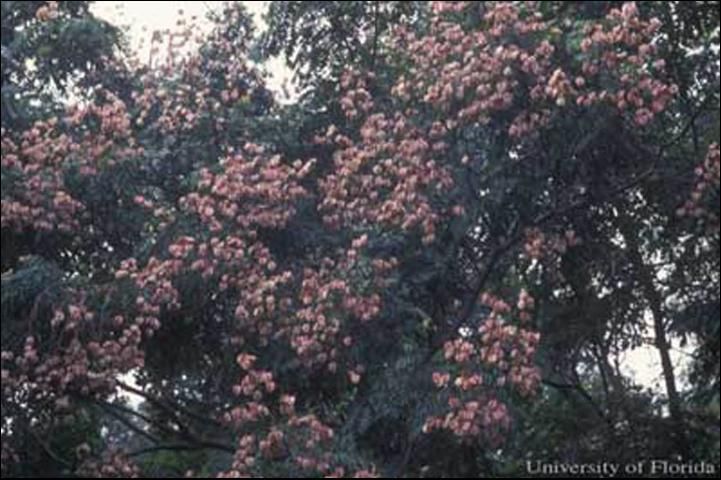
Credit: L. J. Buss, UF/IFAS
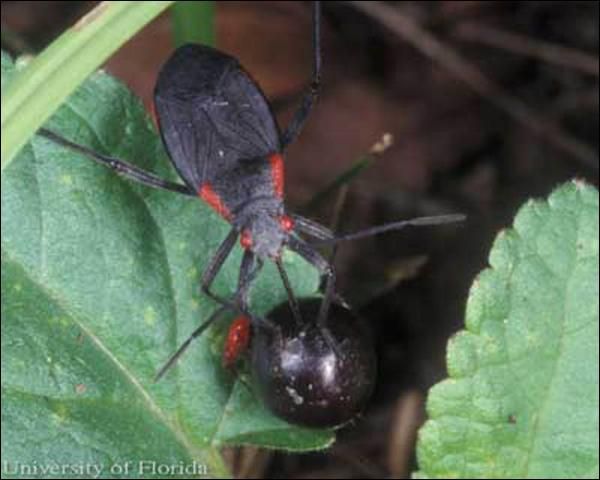
Credit: L. J. Buss, UF/IFAS
Survey and Detection
Examine ground areas under trees shedding seeds, particularly goldenrain trees, where bugs come to feed on the seeds. Look for the dark, red-shouldered 1/2 inch long adults primarily on leaves, stems, and ground areas. Nymphs are mostly a conspicuous red color.
Management
In most instances, no attempts to control Jadera spp. are necessary. Documentation is lacking as far as this being a plant pest of any consequence. A small concentration on a plant often can be destroyed by hand collecting. If the bugs are a nuisance in lawns or playgrounds, raking to remove the seeds that the bugs are feeding on should be helpful. If nonpesticidal methods are not practical, consult your local office of the Cooperative Extension Service for insecticide recommendations.
Selected References
Blatchley, WS. 1926. Heteroptera or true bugs of eastern North America with especial reference to the faunas of Indiana and Florida. Nature Pub. Co., Indianapolis, IN. 1116 p.
Chopra, NP. 1967. The higher classification of the family Rhopalidae (Hemiptera). Trans. Royal Entomol. Soc. London 119: 363–399.
Gollner-Scheiding, U. 1979. Die Gattung Jadera Stal, 1862 (Heteroptera, Rhopalidae). Deutsche Entomologische Zeitschrift 26: 47–75.
Hoebeke, ER, and Wheeler, AG, Jr. 1982. Rhopalus (Brachycarenus) tigrinus, recently established in North America, with a key to the genera and species of Rhopalidae in eastern North America (Hemiptera: Heteroptera). Proc. Entomol. Soc. Washington 85: 213–224.
Schaefer, CW, and Chopra, NP. 1982. Cladistic analysis of the Rhopalidae, with a list of food plants. Ann. Entomol. Soc. Amer. 75: 224–233.
Wheeler, AG, Jr. 1990. Bed bugs and other bugs. Pp. 313–345. In A. Mallis, ed., Handbook of pest control: The behavior, life history, and control of household pests, 7th edit. Franzak & Foster Co., Cleveland, OH.